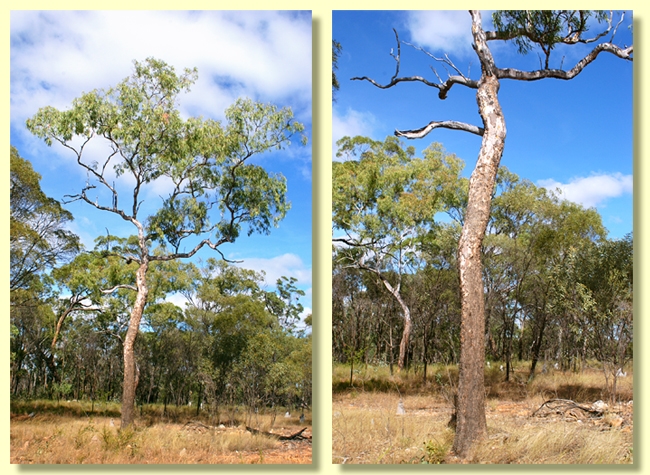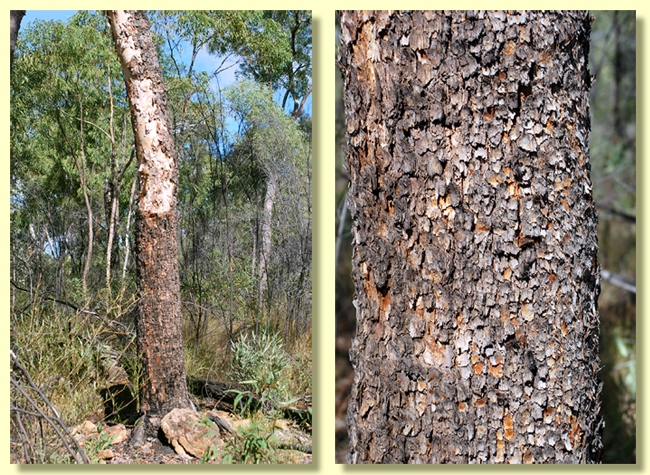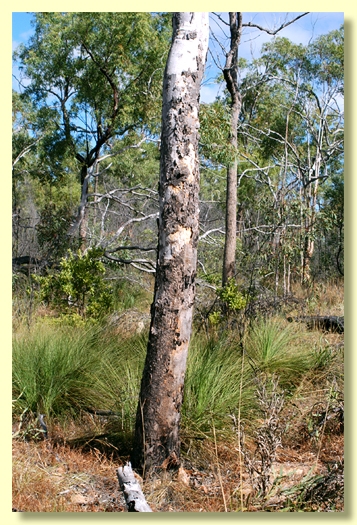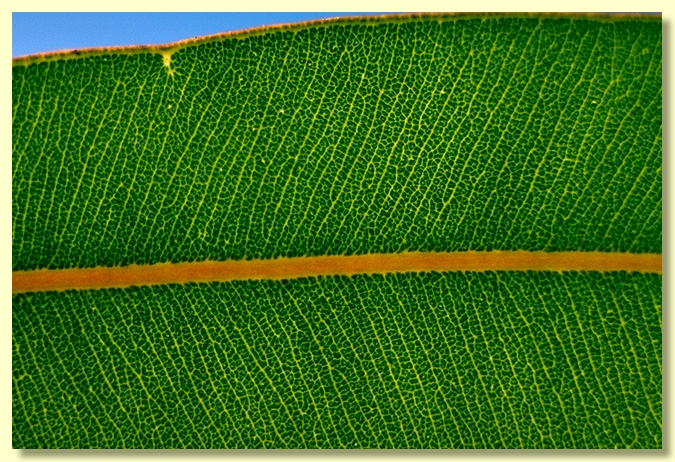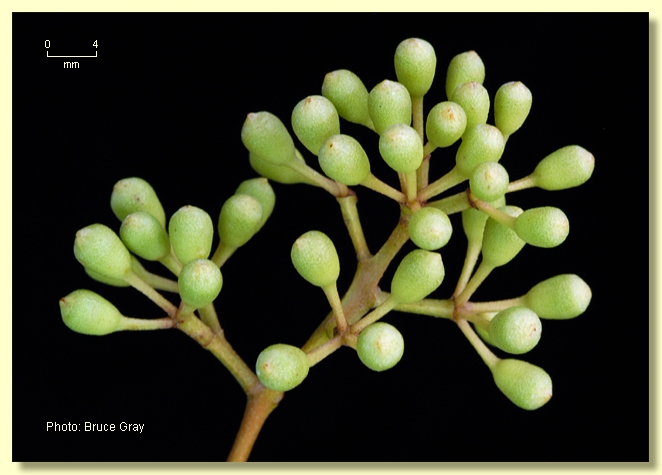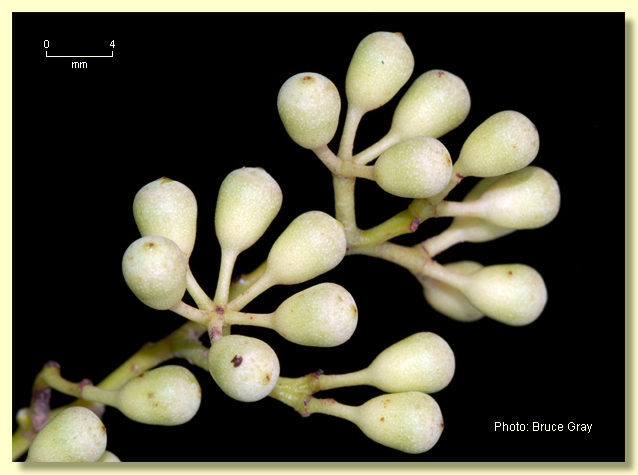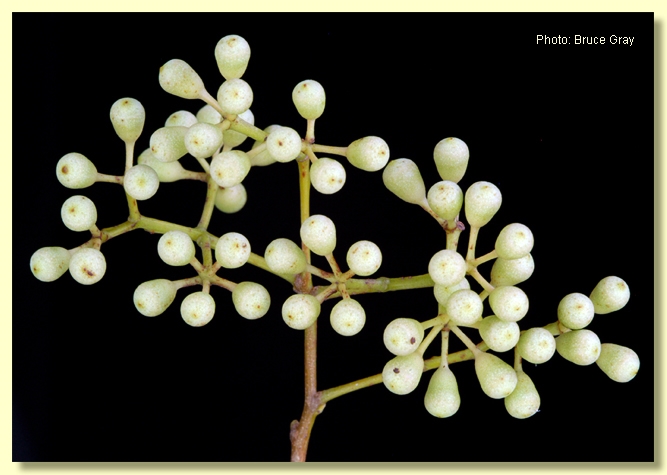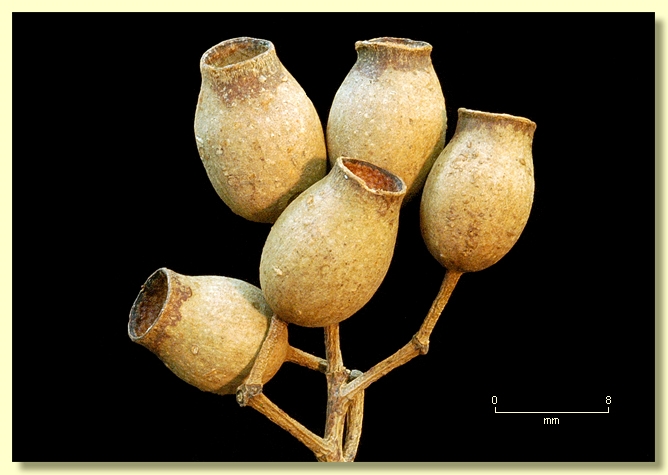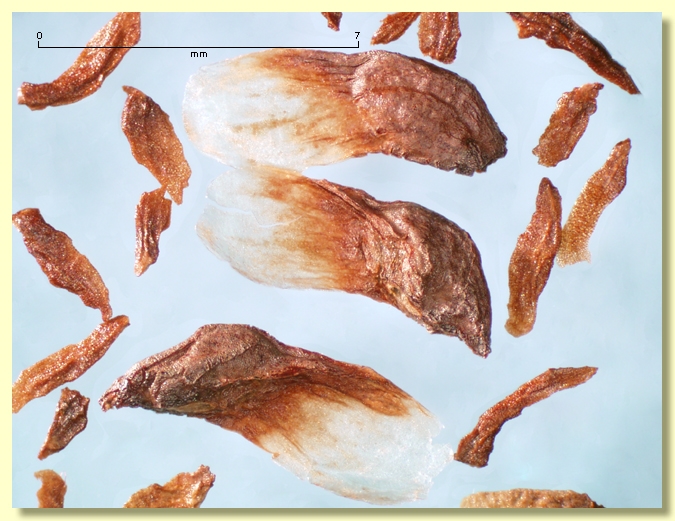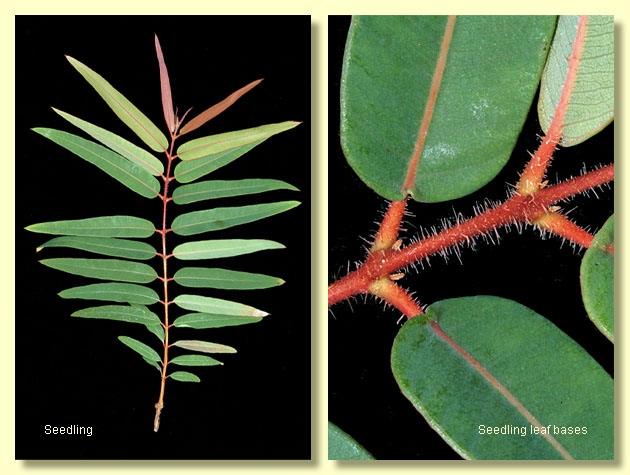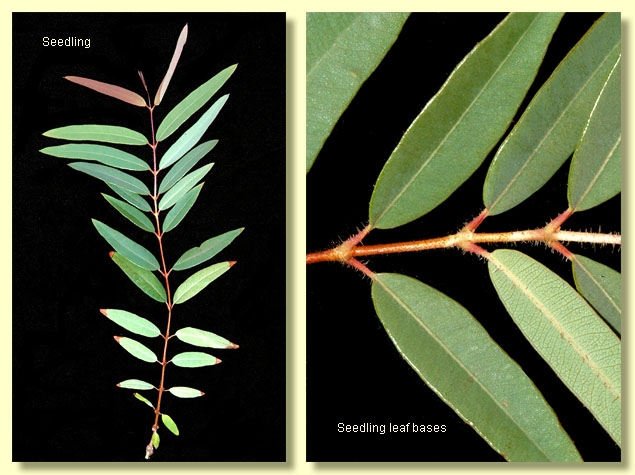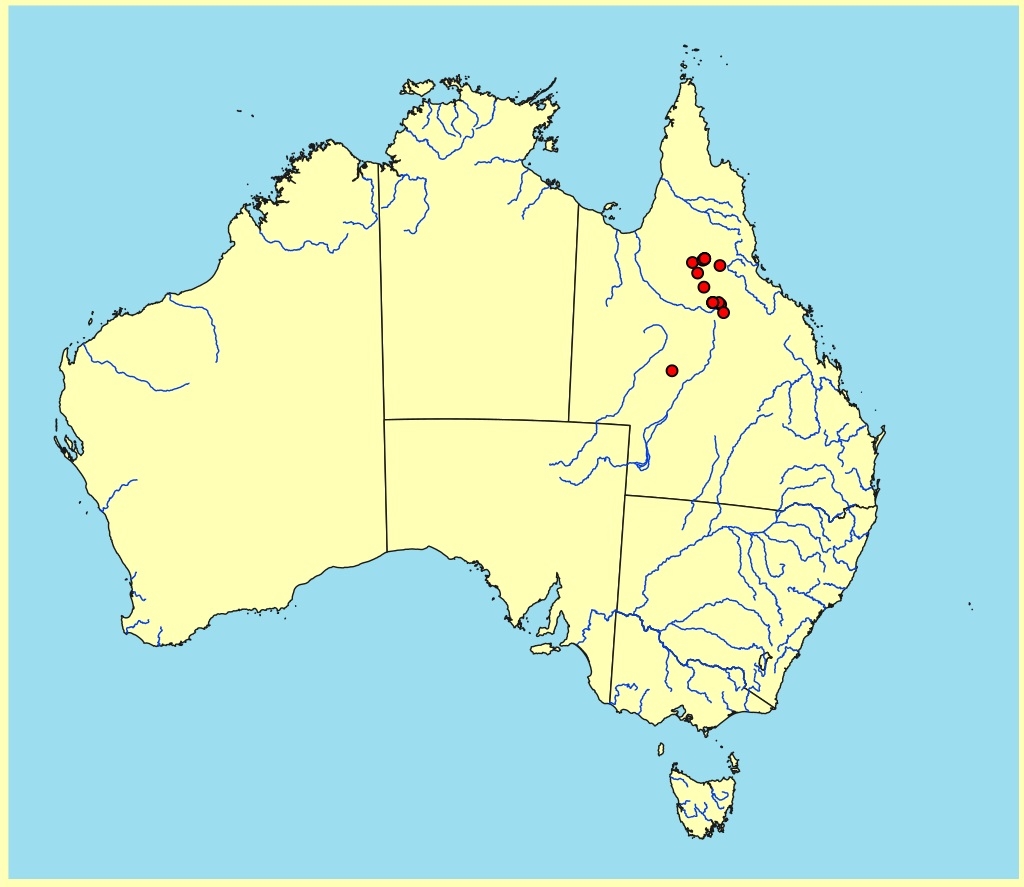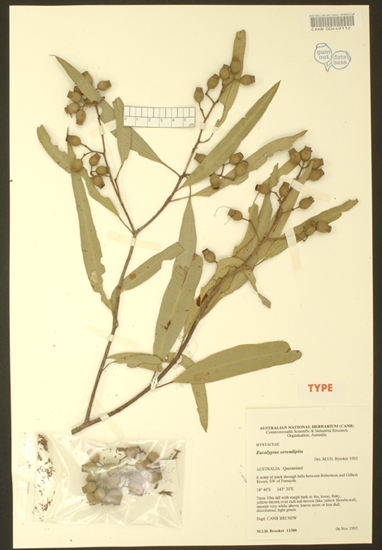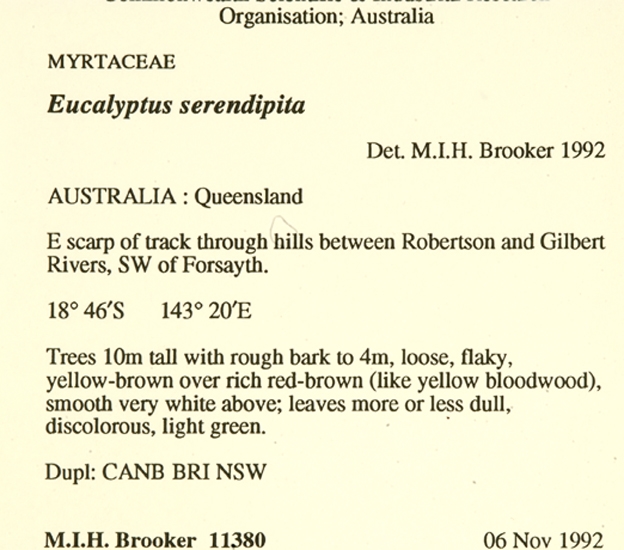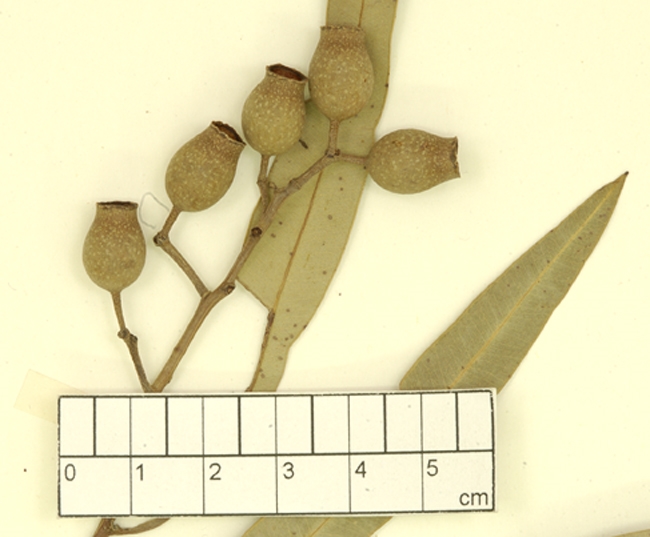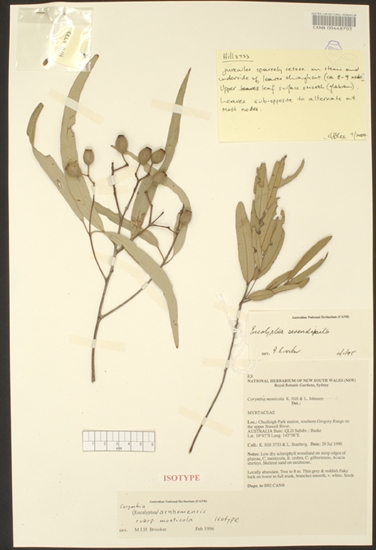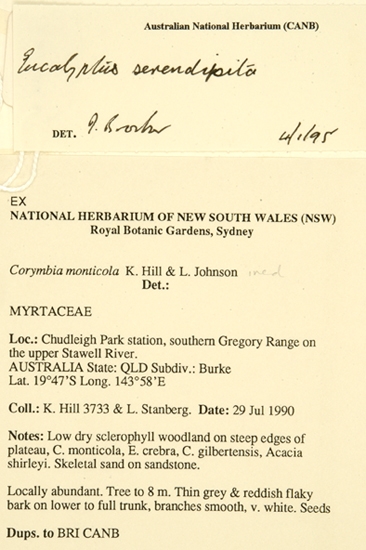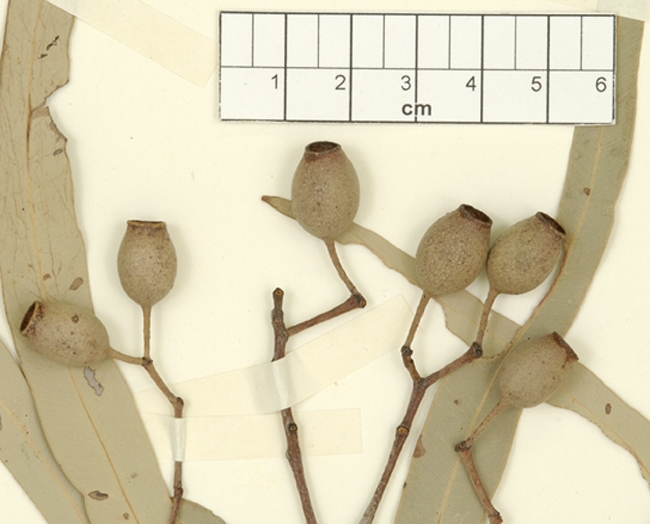Corymbia | Rufaria
Euclid - Online edition
Corymbia serendipita
Corymbia serendipita (Brooker & Kleinig) A.R.Bean, Austrobaileya 6: 345 (2003).
Tree to 12 m tall. Forming a lignotuber.
Bark rough over part or most of trunk, thin, red-brown to orange to greyish, flaky-tessellated, becoming smooth above, powdery, white to cream to whitish grey.
Branchlets smooth; long oil ducts sometimes present in the pith.
Juvenile growth (coppice or field seedlings to 50 cm): stems rounded in cross-section, sparsely setose to scabrid in the lower part becoming smooth after ca 7 nodes; juvenile leaves shortly petiolate, opposite, lanceolate, 6–12 cm long, 1.2–1.8(2.5) cm wide, base tapering, apex pointed, green, discolorous, lower leaves to ca node 5 scabrid with bristle-glands on underside only, upper leaves glabrous; lower leaves also have white, simple, microscopic hairs on underside.
Adult leaves opposite, sub-opposite or alternate, petioles slender 1–2.5 cm long; blade lanceolate or falcate, 7.5–18 cm long, 0.7–1.7(2.2) cm wide, base tapering to petiole, margin entire, apex pointed, discolorous, dull, light green to grey-green, smooth, side-veins at greater than 45° to midrib (penniveined), reticulation dense to very dense, intramarginal vein present but very close to margin and more clearly visible from underside of leaf, oil glands scattered, small and ± island.
Inflorescence terminal compound, peduncles slender and slightly angular, 0.2–1.6 cm long, buds 7 per umbel, pedicels 0.1–1.1 cm long. Mature buds obovoid or pyriform, ca 0.5 cm long, ca 0.4 cm wide, smooth and shiny, scar absent (both opercula shed together at flowering), operculum shallowly rounded and apiculate or not so, stamens inflexed, all fertile, anthers oblong, dorsifixed, versatile, dehiscing by longitudinal slits, style as long, straight, stigma blunt and with a fringe of short papillae, locules 3 or 4, the placentae each with ca 5 vertical ovule rows or the rows indistinct. Flowers not seen.
Fruit pedicellate (pedicels 0.1–1.1 cm long), urceolate with a short neck that is slightly flared at the rim, 1–1.5 cm long, (0.7)0.8–1 cm wide, smooth, disc descending vertically, valves 3 or 4, enclosed.
Seeds brown, 6–9 mm long, ellipsoidal with terminal wing, hilum ventral.
Cultivated seedlings (measured at ca node 10): cotyledons large, reniform; stems rounded in cross-section, densely setose below ca node 9–12, above this sparsely setose to ca node 18 or becoming glabrous; leaves always petiolate, narrowly elliptic-lanceolate to linear, 4.7–10.5 cm long, 0.8–1.8 cm wide, base rounded or tapering, some leaves with peltate bases at nodes 7–12, dull, green, discolorous, upper surface glabrous after node 7–8, underside remaining sparsely setose especially on main veins. Microscopic white simple hairs are present on the underside of the upper seedling leaves, sometimes not well developed and more resembling papillae.
Flowering has been recorded in February.
A bloodwood tree endemic to north Queensland where it is restricted to the Newcastle and Gregory Ranges between Georgetown, Einasleigh and Forsayth, extending south to the White Mountains (Porcupine Gorge area and Torrens Creek). In 2013 it was discovered in western Queensland at Vergemont, W of Longreach, by Rod Fensham. It occurs on dissected sandstone hills and plateaus in skeletal sandy soil. Corymbia serendipita has thinly persistent tessellated bark over part or all of the trunk with the upper trunk and branches shedding to smooth, white and often powdery bark, a dull greenish crown with leaves darker above and paler underneath, and small shiny buds in terminal inflorescences. The urn-shaped fruit are never more than 1 cm wide and 1.4 cm long and seeds are winged. Juvenile growth is scabrid initially but soon becomes smooth, with upper juvenile to intermediate leaves both glabrous and broad. In general appearance the plant has an overall delicate "stalkiness" due to the slender petioles and branchlets.
Within its natural range Corymbia serendipita grows with C. ligans which differs in being fully rough-barked including the branches and has more elongated fruit, but has similar discolorous adult leaves and smooth to slightly scurfy small buds. It also grows with Corymbia trachyphloia, which is also fully rough-barked and has thinner-walled, small fruit and wingless seeds.
Corymbia serendipita is likely to be confused with C. stockeri subsp. stockeri but the latter has rough bark extending to the smaller branches, often has whitish buds due to the thin rubbery cuticle, and broader juvenile leaves.
Eucalyptus serendipita Brooker & Kleinig was reduced to subspecific rank as C. arnhemensis subsp. monticola by Hill & Johnson (1995) but was restored to specific rank as C. serendipita by Queensland botanist Tony Bean (2002). Corymbia serendipita differs from the Northern Territory endemic C. arnhemensis by the latter having juvenile leaves which are lobed to round at the base and the adult leaves lacking conspicuous oil glands.
MORE ABOUT CORYMBIA
MORE ABOUT RED BLOODWOODS
Corymbia serendipita: English serendipity, the faculty of making happy and unexpected discoveries by accident.

